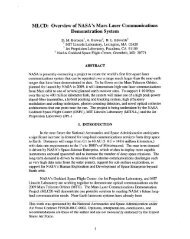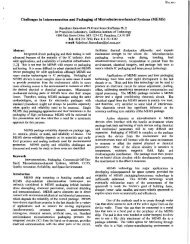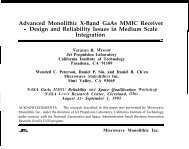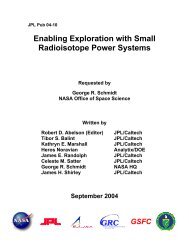f - NASA Jet Propulsion Laboratory Technical Reports Server
f - NASA Jet Propulsion Laboratory Technical Reports Server
f - NASA Jet Propulsion Laboratory Technical Reports Server
You also want an ePaper? Increase the reach of your titles
YUMPU automatically turns print PDFs into web optimized ePapers that Google loves.
electronic sub-assemblies like the gimbal electronics, telemetry electronics and the instrument batteries. The company<br />
fabricated, assembled and flight-tested it prior to integration. They also initiated the FAA registration as an experimental<br />
research and development vehicle and provided a trailer to transport the helicopter. The trailer also serves as a test station.<br />
The helicopter main structure is all composite construction and the helicopter engine is a 120 hp Hirth F-3014~ 2 cycle<br />
engine. The Ultrasport 496 is depicted in figure 5 a-c. Complete cost, Operation and maintenance of the aircraft is<br />
reasonable and one of the main reasons it was chosen as the VIGILANTE platform. A similar aircraft is also on its way to<br />
becoming an Unmanned Aria1 Vehicle (UAV) and our current telemetry system may provide a basis for future Unmanned<br />
operation. It should be noted that the size of the Ultrasport forced the design of the sub-assemblies to be small and low<br />
power. This design constraint may prove useful if current tests ultimately lead to operational airborne or space borne<br />
systems.<br />
(a) (b)<br />
Figure 5. a) Ultrasport Fabrication. b) System Integration. c) Flight Testing.<br />
The Ultrasport 496 is in test phase right now to determine its maximum flight envelope at National Test Pilot School<br />
(NTPS) in Mojave. The VIGILANTE instrumentation has temporarily been installed into a Hughes 500 in order to<br />
optimize schedules for Experiment #l. The Ultrasport 496 should be ready for the next series of experiments and it should<br />
greatly reduce operational costs.<br />
QUANTUM WELL INFRARED PHOTO DETECTOR (OWIP): is a 256x256-pixe1, real-time (30 to 120 Hz) IR sensor<br />
array mounted in an Inframetrics cooler and camera. QWIP is a low-cost, spatially uniform alternative to HgCdTe sensors.<br />
The sensor has an 8 to 9 pm central wavelength detection capability with a 1 pm full width at half maximum, and the<br />
design uses a random reflector on each pixel to maximize light trapping. The QWIP sensors are based on GaAs. The IR<br />
camera is equipped for a 200mm lens with a 2.5 degree field of view.<br />
VISIBLE CAMERA: A color Cohu CCD 768 x 494 pixel camera was used for experiment 1. The camera is mounted with<br />
a Fujinon 300-mm zoom lens. In near future, the CCD camera will be replaced with an active pixel sensor camera.<br />
ULTRAVIOLET CHARGED-COUPLED DEVICE (W CCD) CAMERA: The UV camera is a 1024x1024 pixel, real-time<br />
(30 - 120 Hz) Lumogen coated CCD. The W camera is equipped with 500 mm all reflective optics and various filters for<br />
specified UV and visible wavelengths. The camera has a two-channel digital RS-422 data output (half the sensor is read<br />
out per channel). The UV camera will be mounted on the Optical bench for the next VIGILANTE field experiment.<br />
VIBRATION ISOLATION SYSTEM: The Mechanical Engineering Departments of Catholic University and the University<br />
of Maryland has built an active/passive two stage vibration isolation system. The system operates on passive air mounts<br />
arranged in series with another stage of active electromagnetic actuators. The active stage isolates the base excitation from<br />
the intermediate platform whose vibration is isolated in turn from the primary system by the passive stage. The vibration<br />
isolation box is made of a composite material and contains the actuators, passive isolation, accelerometers and rate triad.<br />
The vibration box is controlled by a computer that logs the data and controls the I/O. The system can operated in two<br />
modes. Continuous operation mode isolates the optical bench with S/W controlled gain parameters, which have been<br />
optimized for a specific camera configuration. In data acquisition mode, the computer logs the output of the accelerometer<br />
and rate triads under various control gain conditions. Normally, this system reduces vibration-related acceleration by a<br />
factor of ten, and it was easily re-tuned during the transition form the Ultrasport 496 to the Hughes 500, where the


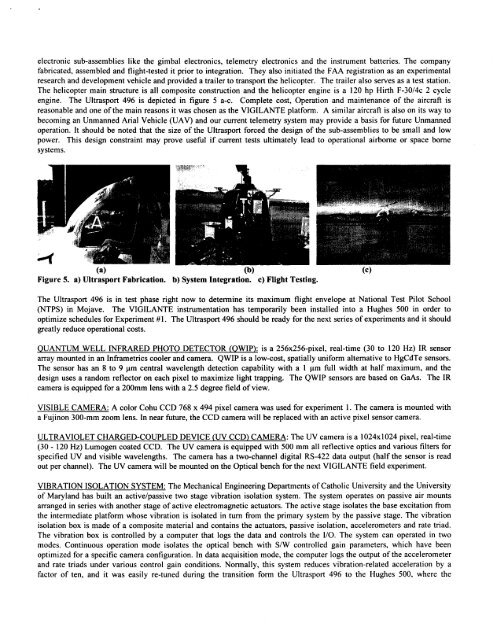
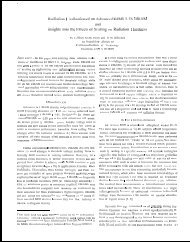


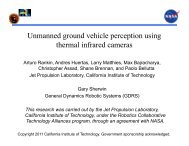



![Ana]ysis of Reaction Products and Conversion Time in the Pyrolysis ...](https://img.yumpu.com/11715548/1/190x242/anaysis-of-reaction-products-and-conversion-time-in-the-pyrolysis-.jpg?quality=85)
